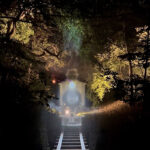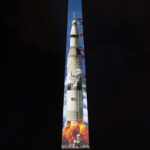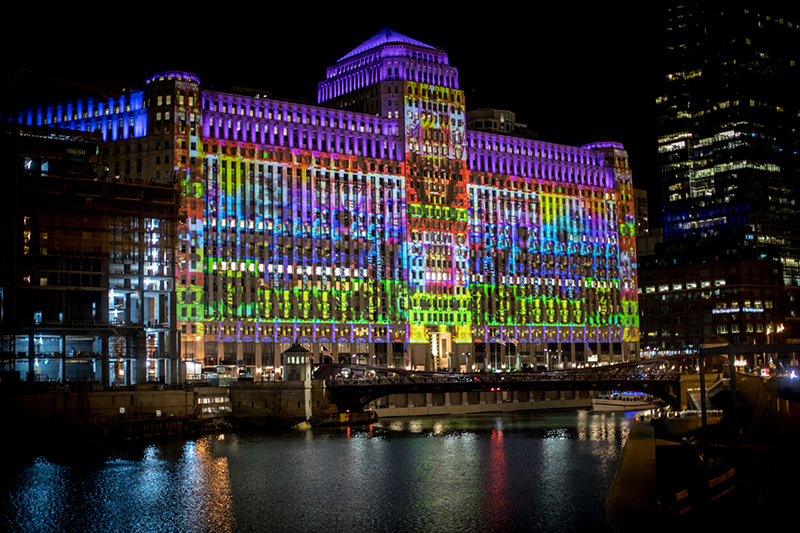
Chicago Building’s 2.5-Acre Façade to Feature Art, Not Ads, for Next 30 Years
Chicago, renowned for its architecture and public art, expanded its reputation dramatically with the launching of Art on theMART in late September. The large format projection is an ever-evolving display brought to the public eye by property management company Vornado Realty Trust (VRT) and architecture firm Valerio Dewalt Train Associates (VDTA).
Partnering with San Francisco based Obscura Digital, known for its large scale architectural projection mapping on many famous buildings around the world, VDTA and VRT paved the way for this one-of-a-kind project, which has been submitted to the Guinness Book of Records as possibly the largest permanent architectural projection system in the world.
In all, 34 Christie 4K30 Boxer projectors cast more than one million lumens of light on the building’s 2.5 acre façade as part of a two-hour projection show that appears five nights a week for 10 months of the year. The project is slated to run for the next 30 years. Obscura designed and created a software-driven platform that allows theMART to curate an ongoing display of imagery from artists transforming their work into a digital platform.
The idea for this $8 million project found its footing with VRT’s restoration of the interior of the building. The Art Deco structure was built by Marshall Field & Co. and, upon its grand opening in 1930, it was cited as the largest building in the world. Along with 4 millions square feet of floor space, the building, formerly known as the Merchandise Mart, was so large it had its own zip code until 2008.
VRT, the current owners of the building, have been continually upgrading the interior in an effort to update it to the modern era. As completion of the interior renovation came near, the owners formed the idea of doing “some sort of projection” on the outside of the building. They reached out to Obscura Digital asking them to do a feasibility study. Two years later the exhibit opened.
The project is an example of how public and private partnerships can overcome obstacles and bear fruit. In this case, Vornado’s government partner is the City of Chicago’s Department of Cultural Affairs and Special Events. “It’s hard to get a government body to justify funding an $8 million project in the face of all their other expenditures to run and service the city and its populace,” says Will Chase, Obscura Digital’s head of communication. “Vornado, who has a very good relationship with the city, became the linchpin to making this all happen.”
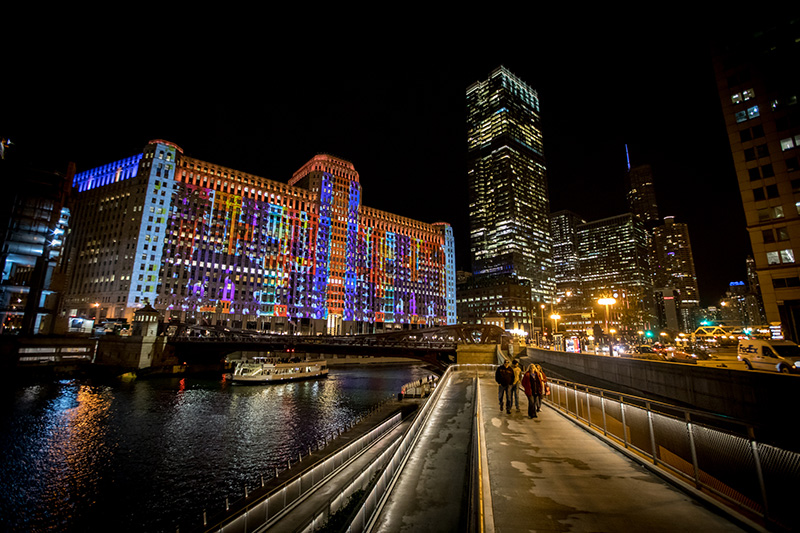
Art Highlights Urban Renewal
The 2.5-acre building sits on land that splits the north and south branches of the Chicago River. On the opposite bank across the river, which at one time literally was a cesspool and blight on the city, lays the limestone Riverwalk. The area adjacent to Riverwalk is now a pleasant green space to hang out and shop at retail stores along the way.
VDTA designed and built the projector housing embedded in the Riverwalk with Obscura’s consultation. “It is a piece of artwork in itself in that it seamlessly integrates beautifully into the Riverwalk,” says Chase.
The enclosure, which houses all 34 projectors, includes a “curtain wall” made of double-paned custom glass with a small air pocket between them. Projectors are mounted on racks that can slide in and out for ease of service.
To create their 3D model in CAD, Obscura laser-scanned theMART, mapping the many facets of the building. Obscura’s proprietary FireFrame image processor engines drive the 34 Christie Digital 4K30 Boxer projectors.
Four contemporary digital artworks from well-known contemporary artists — Diana Thater, Zheng Chongbin, Jason Salavon and Jan Tichy — will be featured as part of the show through the end of the year, and other artists will be able to apply to have their art featured in the future.
“Our software team at Obscura created a Custom Content Management System — CMS — that allows theMART curatorial team to import whatever images they want,” says Chase. This technology then provides curators and artists a broad selection of effects and filters, but leaves the software to process the image and slowly render and resolve it over the course of a customizable time period. Essentially, our software is creating a really beautiful animation out of the artist’s images.”
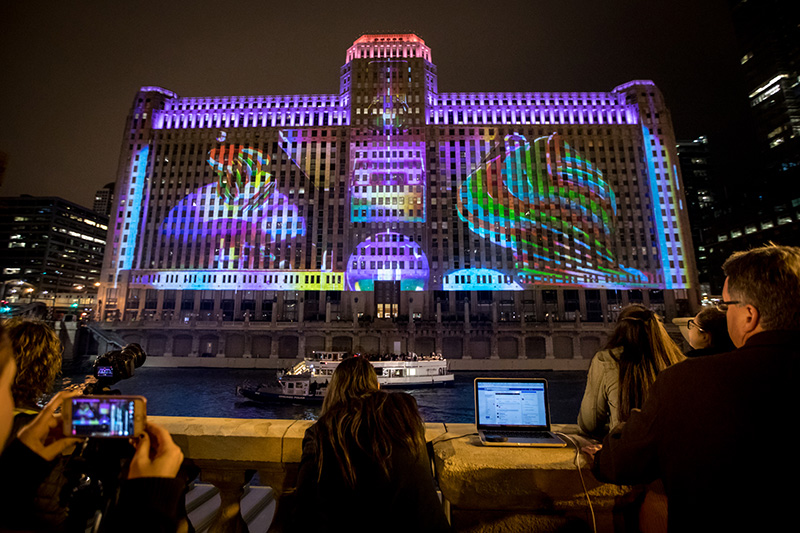
Engineers as Artists
Obscura Digital was founded in 2000 by way of a conversation between Chris Lejeune, who worked for his family-owned geodesic dome company, Pacific Domes, and Travis Threlkel, one of the original members of the band Brian Jonestown Massacre. Threlkel was using projection in the band’s live show. Between the two visionaries, they shared a common interest in creating large scale immersive experiences by putting projections in domes.
Eighteen years later, the employees number around 80 in a large warehouse in San Francisco. “We have a nonstop flow of world-class clients that allow us to do what we do,” says Chase. Recently, the company was bought by Madison Square Garden Company, who have a vision of expanding on Lejeune and Threlkel’s original concept with the MSG Sphere, an 18,000 seat live performance venue offering a shared virtually reality experience that is now under development in Las Vegas.
Obscura is noted for their creations of media and content as well for their client’s architectural projection project.
In this case, Obscura created some content for the opening media, but ultimately what they have done is create an artistic platform for Art on theMART. “The software engineers at Obscura are the real artists this time,” says Chase, “in the sense that they are the ones who created the effects and filters used to process the images. Our software engineers are effectively artists who work with code rather than paint.”
Matthew Ragan, Obscura Digital’s associate director of software, served as lead engineer for the project, managing software and team members assigned to the project, including their communications with other departments.
“One of the challenges that we will see more and more prevalent in work that involves large resolution is the actual time it takes to process renderings, which is not insubstantial,” Ragan says. “The approach we took on this project was to think how the client could upload a photo or series of photos and have the software do a lot of the animation on its own. Similar to an app like Instagram, which provides a set of filters to select from, we likewise designed some very careful filters and abstract patterns that derive their information from the image that is uploaded. I was extremely fortunate to have another very talented programmer, named Mike Walczyk, who did a tremendous amount of work on this project,” Ragan adds. “This was no small task.”
Before his team could even begin writing the software, they spent time on in-depth discussions with the city of Chicago on how the project might affect the daily lives of pedestrians, commuters, and public transportation along with basic power consumption.
“We paid very careful attention to things like how fast the images would resolve, or how rapidly they might animate,” states Ragan. “A concern for the city is they did not want a new art piece inadvertently creating more dangerous situations for pedestrians or drivers.”
The projections appear well after sundown, running for two hours, five days a week. The shows are timed to avoid distracting motorists during rush hour. And to minimize the light intrusion into employee workspaces, the software is programmed to mask out theMART’s building windows.
The team at Obscura has a long history of solving a wide variety of the types of problems mentioned above, as they have done installations all over the world. In the process, the company has learned how to streamline concept to completion schedules. “Concept to completion took only two years For Art on theMART,” Ragan smiles.
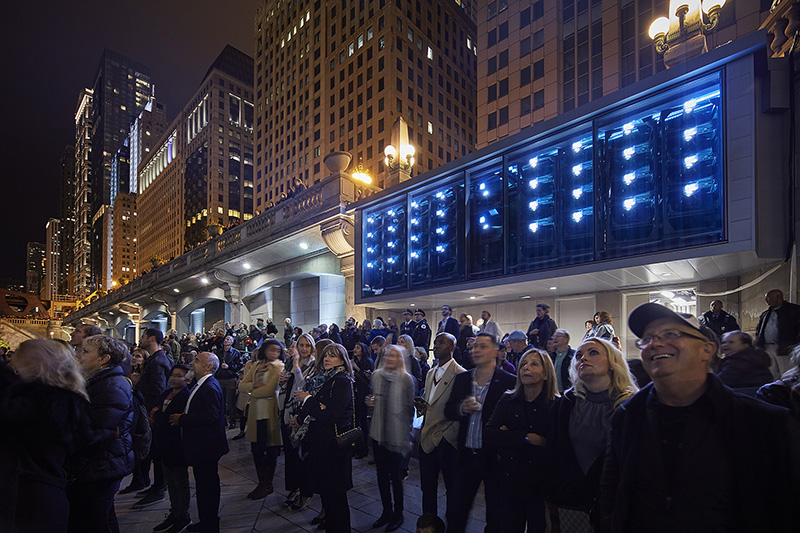
Behind the Glass
Although there are 34 projectors in the housing, in writing the operational software, Ragan only “sees” three separate channels. The left and right sides of the building both take 16 projectors stacked on top of one another in order to make the image bright enough to be seen, which accounts for two channels.
The laborious process to achieve this alignment overlay starts with a dedicated “Master” projector. Technicians then warp each image slightly in the remaining projectors to make sure the other 15 conform to the master. Channel two is created by repeating this process for the other half of the building. The final two projectors cover the tower area as a third channel. These channels overlap and blend seamlessly to create the presentation of continuity across the images.
To create their 3D model in CAD, Obscura laser scanned theMART to map the many facets of the building. A hard-wired workstation that controls the projections is located inside theMART. Here, the client can upload artwork, build out timelines, schedule operation of the show and manage all the media assets. All the actual work happens across the river underneath the projector housing, where Obscura’s proprietary FireFrame image processor engines drive the 34 Christie Digital 30K Lumen 4K Boxer projectors. Obscura also has remote access to all the machines driving the installation so they can jump in should the need arise and make sure everything is running smoothly.
Because the projectors are encased in a housing built into the Riverwalk, they are subject to a great deal of vibration from the passing cars and bus traffic, and the project design includes periodic recalibration to ensure the integrity of the overlapped imagery. Although the slight blurring will be almost indiscernible to the casual viewer, Obscura makes these routine adjustments to the Christie Boxer projectors to keep the images as crisp and sharp as possible.
“We’ve enjoyed working with Obscura as a partner for close to 10 years,” says Paul Dumpel, Christie Digital’s senior account manager for the Americas. “Our first installation with them was done in China.” By the time that discussions for the Chicago project started about two years ago, Dumpel adds, Obscura Digital was already familiar with Christie’s Boxer projectors and their advantages, including “serviceability, reliability, resolution and brightness,” along with a competitive cost-of-ownership profile.
“The fact that the Boxer is very modular makes for service in a public space another essential factor,” Dumpel says, adding that, for the installation at theMART, the project partners agreed that a lamp-based (vs. solid-state) projector was the most viable option. “We are currently working on new illumination technology that will enhance colors quite a bit in the contrasts,” Dumpel notes. “As technology continues to evolve, we will continue bringing those innovations to our customers.”
Along with brightness and resolution, the compact Christie 4K Boxer’s size proved essential to theMART installation, Dumpel continues. “It delivers the full pixels onto the building required to illuminate a canvas that large.” The project required “a lot of work,” he adds, noting the satisfaction everyone felt on opening night, Sept. 29, 2018, “when the first images hit the building.”
Notably, there will be no sponsorship marketing, branding or messaging. That, says Obscura Digital’s Chase, makes this project especially gratifying. Chicago is said to have more public art than any other city in the U.S. “This is adding a new dimension to their renowned public art,” says Chase. “It is not just an art installation; it is an ever evolving art gallery. Our hope is that other cities take it as a model,” he adds. “We want to see more art in the world.”
For more information, visit www.obscuradigital.com, www.christiedigital.com, www.buildordie.com and www.vno.com.
